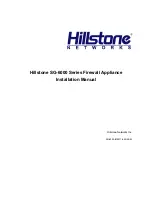
Chapter 20 IPSec VPN
ZyWALL ATP Series User’s Guide
412
In tunnel mode, the Zyxel Device uses the active protocol to encapsulate the entire IP packet. As a
result, there are two IP headers:
• Outside header: The outside IP header contains the IP address of the Zyxel Device or remote IPSec
router, whichever is the destination.
• Inside header: The inside IP header contains the IP address of the computer behind the Zyxel Device
or remote IPSec router. The header for the active protocol (AH or ESP) appears between the IP
headers.
In transport mode, the encapsulation depends on the active protocol. With AH, the Zyxel Device
includes part of the original IP header when it encapsulates the packet. With ESP, however, the Zyxel
Device does not include the IP header when it encapsulates the packet, so it is not possible to verify the
integrity of the source IP address.
IPSec SA Proposal and Perfect Forward Secrecy
An IPSec SA proposal is similar to an IKE SA proposal (see
), except that you also have the
choice whether or not the Zyxel Device and remote IPSec router perform a new DH key exchange every
time an IPSec SA is established. This is called Perfect Forward Secrecy (PFS).
If you enable PFS, the Zyxel Device and remote IPSec router perform a DH key exchange every time an
IPSec SA is established, changing the root key from which encryption keys are generated. As a result, if
one encryption key is compromised, other encryption keys remain secure.
If you do not enable PFS, the Zyxel Device and remote IPSec router use the same root key that was
generated when the IKE SA was established to generate encryption keys.
The DH key exchange is time-consuming and may be unnecessary for data that does not require such
security.
PFS is ignored in initial IKEv2 authentication but is used when re-authenticating.
Additional Topics for IPSec SA
This section provides more information about IPSec SA in your Zyxel Device.
Authentication and the Security Parameter Index (SPI)
For authentication, the Zyxel Device and remote IPSec router use the SPI, instead of pre-shared keys, ID
type and content. The SPI is an identification number.
Note: The Zyxel Device and remote IPSec router must use the same SPI.
Transport Mode Packet
IP Header
AH/ESP
Header
TCP Header Data
Tunnel Mode Packet
IP Header
AH/ESP
Header
IP Header
TCP Header Data
Figure 282
VPN: Transport and Tunnel Mode Encapsulation











































